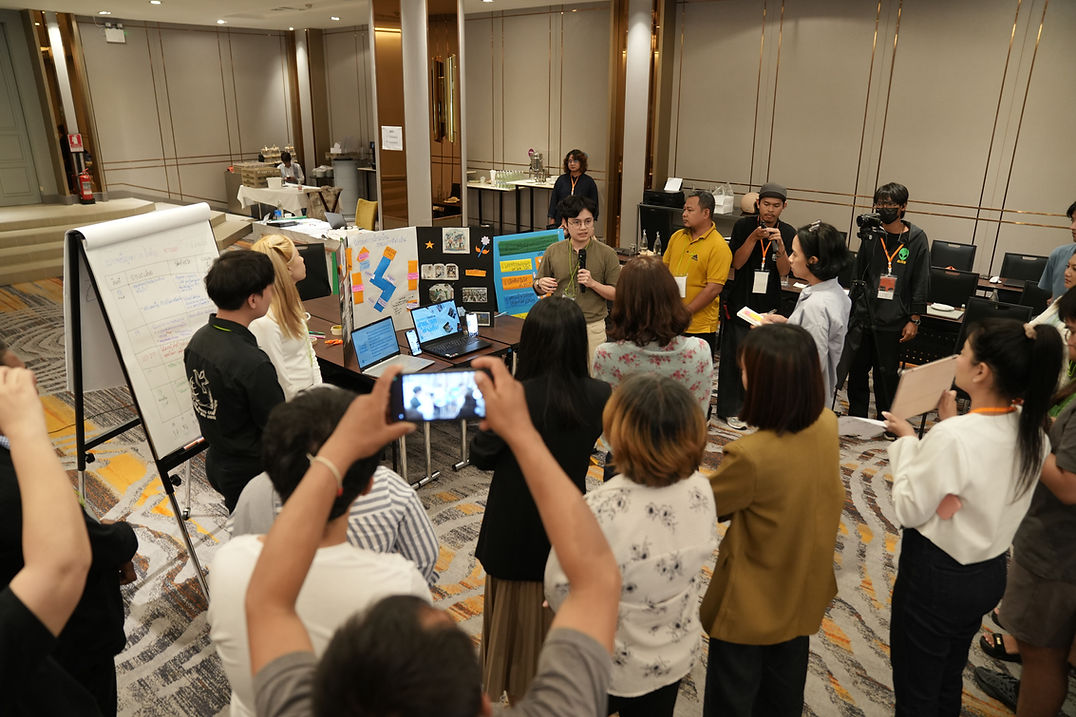

Data-driven storytelling training program
Empowering frontline CSOs to turn insight into influence
Thailand
USAID (CTIP)

Partner
USAID Thailand Counter Trafficking in Persons (CTIP)
-
5 month training program
-
40+ practitioners from over 20 organizations

Why Storytelling? Why Now?
At Sidekick, we believe storytelling is one of the most powerful tools for driving social change—especially when paired with evidence. For organizations working on sensitive and complex issues like human trafficking and migration, stories must do more than inspire. They must build trust, demonstrate impact, and move people to act.
Yet many civil society organizations (CSOs) struggle to translate field-level data into audience-ready messages. To address this gap, Sidekick partnered with the USAID Thailand CTIP project to launch a five-month Data-Driven Storytelling Training Program. The program was designed to equip CSOs with practical skills to tell credible, compelling stories grounded in evidence.
How the Curriculum Was Designed
At the heart of the program was Sidekick’s Case Story Template—a field-tested tool that helps organizations systematically collect qualitative and quantitative information, distill it into a clear narrative arc, and adapt it for different audiences.
The 40-hour curriculum combined active learning, real-life scenarios, and tailored messaging development. It unfolded in three phases:
-
Workshop #1: Foundations – Storytelling principles and ethical data collection.
-
Implementation & Mentorship – Field application of tools supported by weekly check-ins and shared resources.
-
Workshop #2: Messaging and Adaptation – Refining and tailoring stories for donors, the public, and policymakers.
Sidekick's Role
Drawing on over 20 years of experience with CSOs and social impact initiatives, Sidekick designed and delivered a capacity-building curriculum tailored to the realities of organizations working on trafficking and migration in Thailand. This included:
-
Developing the Case Story Template and adapting tools such as the VPSA (Value, Problem, Solution, Action) framework for frontline use
-
Leading all in-person and virtual workshops, blending participatory methods with structured practice
-
Providing tailored support through mentorship, a dedicated Line group, and a real-time resource “sandbox”
-
Curating examples, interview techniques, and exercises reflecting the lived challenges of CSOs working with vulnerable populations

Building Capacity for Impact
Over a five-month learning journey, more than 40 practitioners from 20 CSOs across Thailand took part in the program. Over the course of two workshops and ongoing mentorship, participants learned to:
-
Identify compelling individual narratives and conduct ethical interviews
-
Collect supporting data to validate their work
-
Capture photographs with dignity and respect
-
Draft stories grounded in both narrative and evidence using the Case Story Template
-
Segment audiences—including donors, policymakers, media, and the general public—and adapt their messages accordingly
The final in-person workshop, held over two days, provided a deeper focus on tailoring stories for specific audiences:
-
Media & Policymakers – VPSA storytelling, key message development, and mock press interviews
-
General Public – Audience segmentation and messaging designed to engage “Prospects,” people who might care but need a relatable entry point
-
Donors – Emphasizing credibility, local impact, and transparency, drawing on real examples from partners like Winrock International and USAID
Practical tools for real-life application
What set this program apart was its day-to-day practicality. Participants worked with their own data, interviews, and outcomes—turning learning into immediate practice. By the end of the program, every organization left with:
-
A working case story
-
A clearer messaging strategy
-
An understanding of how to adapt tone, data, and format across channels (stories, photo essays, social media, etc.)
The Sandbox: A Shared Learning Space
To sustain practice beyond the workshops, Sidekick created the Storytelling Sandbox—a private online workspace for feedback, peer exchange, and resource sharing. Participants used it to:
-
Upload draft stories, transcripts, and photos for mentor review
-
Access templates, training decks, and ethical guidelines
-
Learn from peer case stories
-
Continue experimenting and refining communication materials
Several CSOs have since continued using the Sandbox to onboard staff, refine donor communications, and prepare advocacy materials.
The Outcome: Turning Insight into Action
Feedback from participants was overwhelmingly positive, with many highlighting that this was the first time they systematically combined storytelling with data:
“After completing the template, I could clearly see its impact and apply it directly to my work.”
Others noted renewed confidence in communicating their mission—not only to donors, but to the public and decision-makers.
Looking Ahead
This was more than a workshop; it marked a transformation in how CSOs communicate. By building internal capacity to blend field stories with credible data, organizations are now better positioned to:
-
Raise awareness
-
Build donor trust
-
Influence policy
We’re proud to have supported them on this journey—and look forward to seeing how their stories continue to drive change.
.png)



